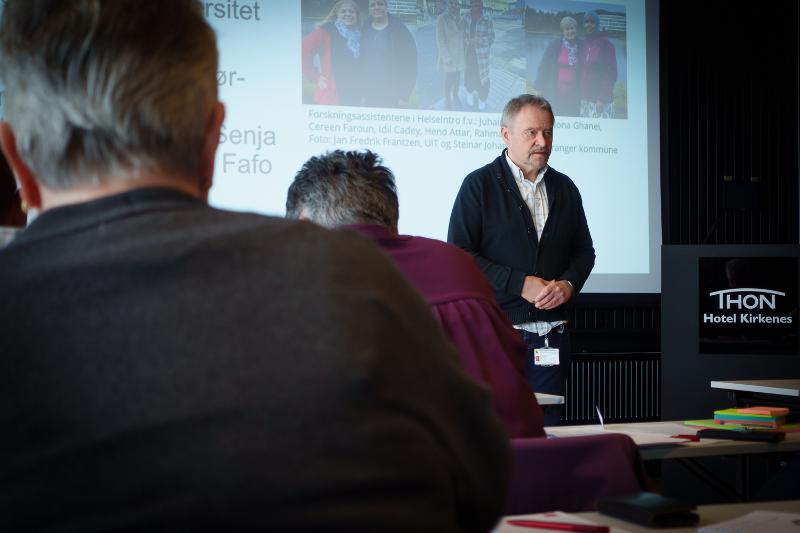The Fast Track is Too Fast
- Six months is too little time to learn Norwegian and make yourself attractive in the job market.

Steinar Johansen works at the Kirkenes Refugee and Competence Unit in the north eastern part of Norway. There, he has had close contact with refugees for the last 10 years. Initially as a program advisor in the Introduction Program, and since 2016 as a professional consultant.
Now, he works with oral Norwegian training, career learning, competence mapping, and other measures in the Introduction program. He is also the representative for Sør-Varanger municipality in the research project HelseIntro at UiT. In other words, Johansen does a bit of everything, as one often must in a smaller municipality.
- We want the refugees to feel welcome when they come to the municipality. Therefore, we emphasize arranging the apartments completely finished with everything from furniture, food in the refrigerator, to cutlery in the kitchen drawers. The refugees are very satisfied with this. But it is when everyday life arrives and the "honeymoon phase" is over that we must try to keep them upright, he explains.
Better Information Than Before
Johansen says that several things have improved in the Introduction Program, both locally and nationally.
- Locally, we have achieved better cooperation with the Norwegian labour- and welfare administration NAV, we are better at facilitation, and we work more systematically together with the participants on the individual plans they should have. Participants in the program do not follow the school calendar, but the time regulations in the rest of the professional life. We have become better at preparing well in advance, such as when there is teacher-free time and eight weeks of summer vacation, autumn break, and winter break. The intro participants should have a sensible program then too.
But the national frameworks for the program have also improved in recent years, explains Johansen. The information from the client, the Directorate of Integration and Diversity (IMDi), has improved and it has come in many languages. IMDi has also published information films in various languages.
- It is also a positive development with the user evaluations that the refugees receive, where they are asked, among other things, about how they are received and whether they are treated with respect.
The Problem with Differentiation
But there is one point where Johansen thinks it has gone too quickly. Where good intentions can throw a spanner in the works for the refugees.
He explains that the differentiation in the new introduction law from 2022 is very good at the long end of the scale, where those who need it most can use up to four years in the Introduction Program. But it is primarily at the "fast" end of the scale that problems can arise.
- The fast track of six months is aimed at those with secondary or higher education. Most Ukrainians fall into this category. But it is not a given that high education automatically leads to rapid language learning and societal understanding. Especially not if you also struggle with traumas from experiences of war.
Therefore, he believes that they need more time to learn enough language and societal understanding to be attractive in the Norwegian job market. The fact that those who have high school from their home country get a shorter introduction program puts a lot of pressure on this group to learn Norwegian quickly, and get a job.
- You send them onto the assembly line, and then it is expected that they get a permanent connection to the labor market after a short time. This probably works better in theory than in practice, he explains.

Digital Challenges
There is another area where Steinar Johansen would like to see more time and resources allocated in the training the refugees receive in the Introduction Program.
Norway is perhaps one of the most digitalized countries in the world. We use the phone for everything from paying bills to ordering a new tax card, but this is a whole new world for most of the refugees.
- We actually spend a lot of time helping them communicate digitally with public agencies, and even on paying bills. There is a great need to get digital learning onto the timetable in the Introduction Program.
Steinar's Dream Intro
So, what is his dream scenario for the Introduction Program? How should it be set up, both locally and nationally?
- There is a lot we can do locally. For example, we should have more time for individual adaptation and facilitation for the refugees. We must also get better at coordination with the public services such as NAV, health care, and schools, and we must get even better at engaging potential employers.
He also sends out a call to the business community in Norwegian municipalities.
- Let people try themselves in the labor market without speaking Norwegian perfectly. These are nice and friendly people who want to contribute to society, and they are interested in learning.
The Refugee Services in Sør-Varanger
The Kirkenes Refugee and Competence Unit is responsible for settlement, establishment, the Introduction program, adult education, qualification, and recognition of qualifications for newly arrived refugees. The unit shall provide necessary language and basic education so that immigrants can participate in professional and social life as quickly as possible and achieve economic independence.
The unit offers Norwegian language training to family reunifications and labor immigrants, as well as basic education for adults. The Refugee and Competence Unit conducts Norwegian language tests, social studies tests, and citizenship tests. Upon request, the unit organizes and conducts external exams for universities and colleges in Norway.